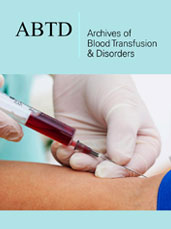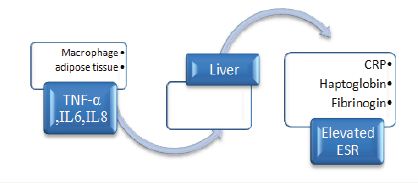- Submissions

Full Text
Archives of Blood Transfusion & Disorders
The Role of Adipose Tissue in Elevate ESR Level in Obese Persons
Walaa Fikry Elbossaty*
Department of Chemistry, Biochemistry division, Faculty of Science, Damietta University, Egypt
*Corresponding author: Walaa Fikry Elbossaty, Department of Chemistry, Biochemistry division, Faculty of Science, Damietta University, Egypt
Submission: August 21, 2017; Published: September 27, 2017

ISSN: 2578-0239Volume1 Issue1
Abstract
Erythrocyte sedimentation rate is simple, in expensive inflammatory marker. ESR level increase in any cases of inflammation. There is various factor effects on level of ESR. ESR level depend on pro inflammatory products and shape of red blood cells, any factors effect on them lead to elevate ESR rate. Obesity is chronic health problem result from unbalance between calories take and body required calories. Obesity correlate with inflammation through adipose tissue, which responsible for secretion of proinflammatory cytokines which in turn increase ESR level. So, there is strong correlation between Obesity and ESR level.
Keywords:ESR; Obesity; CRP; Ferritin; Fibrinogen; Haptoglobin
Introduction
Obesity
Obesity is a serious health problem worldwide, which characterized by elevated inflammatory markers. It has been on the rise through the last decade due to changes in eating habits and a reduction in physical activity [1]. Obesity is a consequence of numerous risk factors, included increased energy consumption, not sleeping enough, Endocrine disruptors, smoking, some medications, obesity genes and reduced physical exercise [2].
Erythrocyte sedimentation rate (ESR)
Is the rate of fall down red blood cells, when anticoagulant whole blood passes through narrow vertical tube. ESR rate measure by millimeters of RBCs per hours.ESR is non-specific, but sensitive inflammatory marker. The level of ESR depend on the formation of rouleaux, the formation of rouleaux depend on the balance between zeta potential and pro inflammatory factors. Pro inflammatory factors also called acute phase reactant, acute phase reactant increase during inflammation process [3]. Acute phase reactants included ferritin, CRP, haptoglobin. Increases of acute phase reactants lead to elevated ESR. There are another pathological conditions included anemia, macrocytosis, Obesity, Pregnancy, Hypercholesterolemia. On the other hand level of ESR decrease in Polycythemia, microcytosis, Sicklecells, spherocytosis, hypogammaglobulinemia, hypofibrinogenemia, High WBC count, hyperviscosity. There are physiological condition lead to increase ESR level as sex and age. Raised ESR is a significant diagnostic criterion for polymyalgia rheumatic and temporal arteritis. ESR may be helpful in detecting occult disease. The most common causes of an elevated ESR in acuteinfection, inflammation, malignancy, systemic lupus erythematous and renal disease. Also, ESR can be differentiating between Iron deficiency anemia and anemia of chronic disease [4].
Interaction between obesity and ESR
Obesity is characterized with increase concentrations of circulating inflammatory cytokines. The chief source of proinflammatory cytokines in obesity is the adipose tissue; they are predominantly produced by macrophages. Adipose tissue is a vital source of cytokines and contributes to the inflammatory process [5]. During inflammation process adipose tissue, and macrophage secrete various cytokines, and interleukins such as TNF alpha, IL6, IL8 which are responsible for estimate the liver to produce fibrinogen, CRP, haptoglobin. Increase inflammation responsible for increase production of fibrinogen which in turn increases ESR level as in Figure 1 [6].
Figure 1: Interaction between obesity and ESR.

Conclusion
In our review obesity was associated with inflammatory markers such as ESR, and fibrinogen levels. Secretion of cytokines in obese people responsible for increase rate of inflammation, hence elevate ESR level.
References
- Güngör NK (2014) Overweight and Obesity in Children and Adolescents. J Clin Res Pediatr Endocrinal 6(3): 129-143.
- Hruby A, Hu FB (2015) The Epidemiology of Obesity: A Big Picture. Pharmacoeconomics 33(7): 673-689.
- Harrison M (2015) Erythrocyte sedimentation rate and C-reactive protein. Aust Prescr 38(3): 93-94.
- Litao MK, Kamat D (2014) Erythrocyte sedimentation rate and c -reactive protein: how best to use them in clinical practice. Pediatr Ann 43(10): 417-420.
- Boutens L, Stienstra R (2016) Adipose tissue macrophages: going off track during obesity. Diabetologia 59(5): 879-894.
- Kang YE, Kim JM, Joung KH, Lee JH, You BR, et al. (2016) The Roles of Adipokines, Proinflammatory Cytokines, and Adipose Tissue Macrophages in Obesity-Associated Insulin Resistance in Modest Obesity and Early Metabolic Dysfunction. PLoS One 11(4): e0154003.
© 2017 Walaa Fikry Elbossaty. This is an open access article distributed under the terms of the Creative Commons Attribution License , which permits unrestricted use, distribution, and build upon your work non-commercially.
 a Creative Commons Attribution 4.0 International License. Based on a work at www.crimsonpublishers.com.
Best viewed in
a Creative Commons Attribution 4.0 International License. Based on a work at www.crimsonpublishers.com.
Best viewed in 







.jpg)





























 Editorial Board Registrations
Editorial Board Registrations Submit your Article
Submit your Article Refer a Friend
Refer a Friend Advertise With Us
Advertise With Us
.jpg)






.jpg)













.bmp)
.jpg)
.png)
.jpg)














.png)

.png)



.png)






